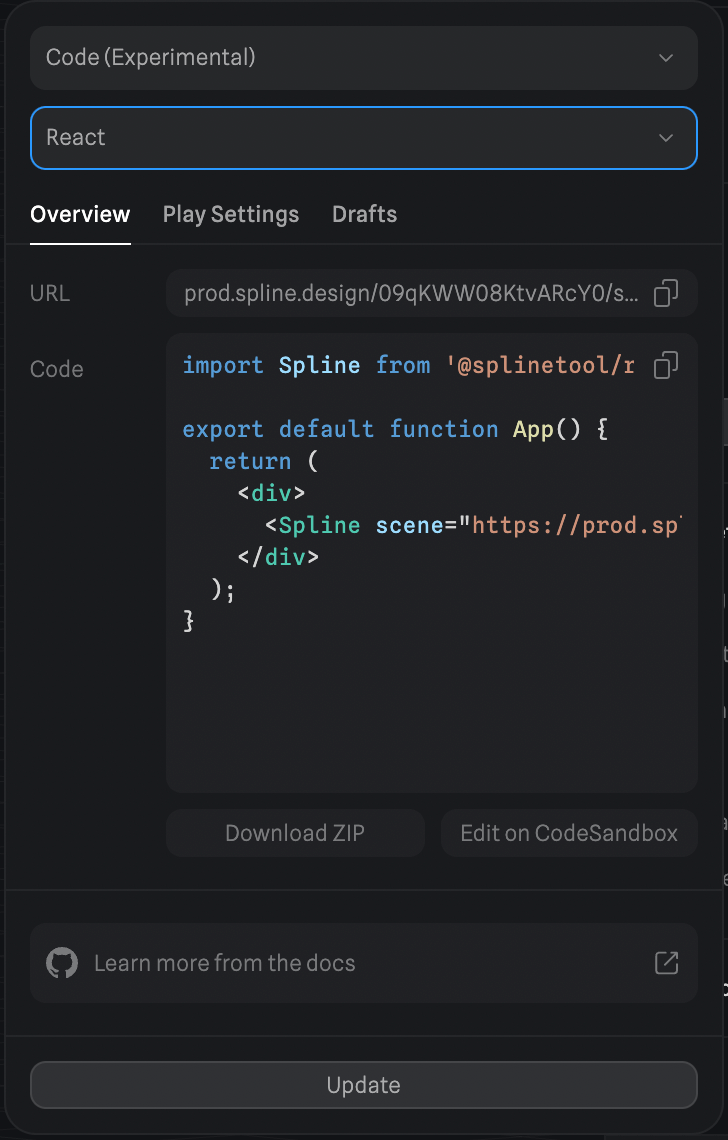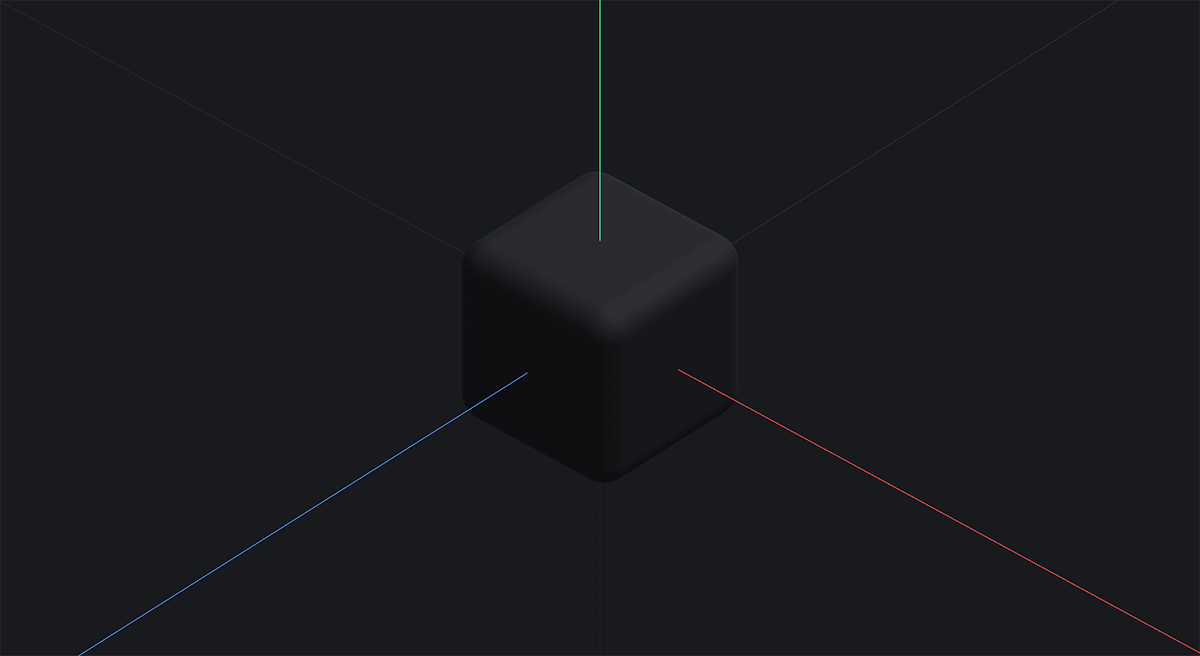Ecosyste.ms: Awesome
An open API service indexing awesome lists of open source software.
https://github.com/splinetool/react-spline
React component for Spline scenes.
https://github.com/splinetool/react-spline
react
Last synced: 6 days ago
JSON representation
React component for Spline scenes.
- Host: GitHub
- URL: https://github.com/splinetool/react-spline
- Owner: splinetool
- License: mit
- Created: 2021-11-19T08:58:16.000Z (over 3 years ago)
- Default Branch: main
- Last Pushed: 2024-06-20T13:57:39.000Z (8 months ago)
- Last Synced: 2025-02-07T11:06:14.406Z (13 days ago)
- Topics: react
- Language: TypeScript
- Homepage:
- Size: 3.77 MB
- Stars: 1,238
- Watchers: 15
- Forks: 63
- Open Issues: 33
-
Metadata Files:
- Readme: README.md
- License: LICENSE
Awesome Lists containing this project
README
[](https://my.spline.design/splinereactlogocopycopy-eaa074bf6b2cc82d870c96e262a625ae/)
# react-spline
**react-spline** allows you to export and use Spline scenes directly in your React websites.
🌈 [Spline](https://spline.design/) is a friendly 3d collaborative design tool for the web.
[Website](https://spline.design/) —
[Twitter](https://twitter.com/splinetool) —
[Community](https://discord.gg/M9hNDMqvnw) —
[Documentation](https://docs.spline.design/)
## Table of Contents
- [Install](#install)
- [Usage](#usage)
- [Next.js](#nextjs)
- [Read and modify Spline objects](#read-and-modify-spline-objects)
- [Listen to events](#listen-to-events)
- [Trigger Spline events from outside](#trigger-spline-events-from-outside)
- [Lazy loading](#lazy-loading)
- [API](#api)
- [Spline Component Props](#spline-component-props)
- [Spline App Methods](#spline-app-methods)
- [Spline Events](#spline-events)
- [Contributing](#contributing)
## Install
```bash
yarn add @splinetool/react-spline @splinetool/runtime
```
or
```bash
npm install @splinetool/react-spline @splinetool/runtime
```
## Usage
To use react-spline, first you have to go to the Spline editor, click on the **Export** button, select "**Code**" and then "**React**".
You should see this:

You can copy the URL and pass it to the `` component in react:
```jsx
import Spline from '@splinetool/react-spline';
export default function App() {
return (
);
}
```
You should be able to see the scene you exported in your React app.
[](https://codesandbox.io/s/sweet-rain-28pcxt?file=/src/App.js)
**NOTE**: If you are experiencing CORS issues, you can download the .splinecode file and self-host it; this will fix any CORS issue. To download, go to Spline's code export panel and click on the download icon visible in the prod.spline textarea.
### Next.js
You can use this library in Next.js as well to take advantage of Server Side Rendering. By default the library will render on the client only, but if you use the import `@splinetool/react/next` the server will render an autogenerated blurred placeholder.
Here is an example. Export as `Next.js` from the Spline editor to autogenerate the placeholder.
```js
import Spline from '@splinetool/react-spline/next';
export default function App() {
return (
);
}
```
### Read and modify Spline objects
You can query any Spline object via `findObjectByName` or `findObjectById`.
_(You can get the ID of the object by right-clicking on it and selecting `Copy Development Object ID`)._
```jsx
import { useRef } from 'react';
import Spline from '@splinetool/react-spline';
export default function App() {
const cube = useRef();
function onLoad(spline) {
const obj = spline.findObjectByName('Cube');
// or
// const obj = spline.findObjectById('8E8C2DDD-18B6-4C54-861D-7ED2519DE20E');
// save it in a ref for later use
cube.current = obj;
}
function moveObj() {
console.log(cube.current); // Spline Object => { name: 'Cube', id: '8E8C2DDD-18B6-4C54-861D-7ED2519DE20E', position: {}, ... }
// move the object in 3D space
cube.current.position.x += 10;
}
return (
Move Cube
);
}
```
### Listen to Spline Events
You can listen to any Spline Event you set in the Events panel of the editor by attaching a listener to the Spline component.
```jsx
import Spline from '@splinetool/react-spline';
export default function App() {
function onSplineMouseDown(e) {
if (e.target.name === 'Cube') {
console.log('I have been clicked!');
}
}
return (
);
}
```
You can find a list of all of the Spline Event listeners in the [Spline Component Props](#spline-component-props) section.
### Trigger Spline events from outside
You can trigger any animation Event you set in the Events panel in the Spline Editor.
You can use the `emitEvent` function via the spline ref, passing the [event type](#spline-events) and the ID of your object.
_(You can get the ID of the object in the `Develop` pane of the right sidebar)._
```jsx
import { useRef } from 'react';
import Spline from '@splinetool/react-spline';
export default function App() {
const spline = useRef();
function onLoad(splineApp) {
// save the app in a ref for later use
spline.current = splineApp;
}
function triggerAnimation() {
spline.current.emitEvent('mouseHover', 'Cube');
}
return (
Trigger Spline Animation
);
}
```
Or you can query the spline object first, and then trigger the event:
```jsx
import { useRef } from 'react';
import Spline from '@splinetool/react-spline';
export default function App() {
const objectToAnimate = useRef();
function onLoad(spline) {
const obj = spline.findObjectByName('Cube');
// save the object in a ref for later use
objectToAnimate.current = obj;
}
function triggerAnimation() {
objectToAnimate.current.emitEvent('mouseHover');
}
return (
Trigger Spline Animation
);
}
```
You can find a list of all of the Spline Events you can pass to the `emitEvent` function in the [Spline Events](#spline-events) section.
### Lazy loading
To start loading react-spline after the whole website has finished loading, we can use lazy-loading. This technique can be achieved using [`React.lazy()`](https://it.reactjs.org/docs/code-splitting.html#reactlazy) in combination with dynamic imports:
```jsx
import React, { Suspense } from 'react';
const Spline = React.lazy(() => import('@splinetool/react-spline'));
export default function App() {
return (
Loading...}>
);
}
```
More info in the [relative React documentation](https://it.reactjs.org/docs/code-splitting.html).
## API
### Spline Component Props
These are all the props you can pass to the `` component.
| Name | Type | Description |
| --------------------- | ------------------------------- | ----------------------------------------------------------------------------------------------------------------------------- |
| `scene` | `string` | Scene file |
| `onLoad?` | `(spline: Application) => void` | Gets called once the scene has loaded. The `spline` parameter is an instance of the [Spline Application](#spline-app-methods) |
| `renderOnDemand?` | `boolean` | Wether or not to enable [on demand rendering](https://threejs.org/manual/#en/rendering-on-demand). Default `true`. |
| `className?` | `string` | CSS classes |
| `style?` | `object` | CSS style |
| `id?` | `string` | Canvas id |
| `ref?` | `React.Ref` | A ref pointing to div container element. |
| `onSplineMouseDown?` | `(e: SplineEvent) => void` | Gets called once a Spline `Mouse Down` event is fired |
| `onSplineMouseHover?` | `(e: SplineEvent) => void` | Gets called once a Spline `Mouse Hover` event is fired |
| `onSplineMouseUp?` | `(e: SplineEvent) => void` | Gets called once a Spline `Mouse Up` event is fired |
| `onSplineKeyDown?` | `(e: SplineEvent) => void` | Gets called once a Spline `Key Down` event is fired |
| `onSplineKeyUp?` | `(e: SplineEvent) => void` | Gets called once a Spline `Key Up` event is fired |
| `onSplineStart?` | `(e: SplineEvent) => void` | Gets called once a Spline `Start` event is fired |
| `onSplineLookAt?` | `(e: SplineEvent) => void` | Gets called once a Spline `Look At` event is fired |
| `onSplineFollow?` | `(e: SplineEvent) => void` | Gets called once a Spline `Mouse Up` event is fired |
| `onSplineScroll?` | `(e: SplineEvent) => void` | Gets called once a Spline `Scroll` event is fired |
### Spline App Methods
The object exposed as a first argument of the `onLoad` function, is a Spline Application. You can call all these different methods on it.
| Name | Type | Description |
| ------------------ | ---------------------------------------------------------- | --------------------------------------------------------------------------------------------------------------------------- |
| `emitEvent` | `(eventName: SplineEventName, nameOrUuid: string) => void` | Triggers a Spline event associated to an object with provided name or uuid. |
| `emitEventReverse` | `(eventName: SplineEventName, nameOrUuid: string) => void` | Triggers a Spline event associated to an object with provided uuid in reverse order. Starts from last state to first state. |
| `findObjectById` | `(uuid: string) => SPEObject` | Searches through scene's children and returns the object with that uuid. |
| `findObjectByName` | `(name: string) => SPEObject` | Searches through scene's children and returns the first object with that name. |
| `setZoom` | `(zoom: number) => void` | Sets the initial zoom of the scene. |
### Spline Events
These are all the Spline event types that you can pass to the `emitEvent` or `emitEventReverse` function.
| Name | Description |
| ------------ | --------------------------------------------- |
| `mouseDown` | Refers to the Spline `Mouse Down` event type |
| `mouseHover` | Refers to the Spline `Mouse Hover` event type |
| `mouseUp` | Refers to the Spline `Mouse Up` event type |
| `keyDown` | Refers to the Spline `Key Down` event type |
| `keyUp` | Refers to the Spline `Key Up` event type |
| `start` | Refers to the Spline `Start` event type |
| `lookAt` | Refers to the Spline `Look At` event type |
| `follow` | Refers to the Spline `Mouse Up` event type |
## Contributing
We use [yarn](https://yarnpkg.com/), install the dependencies like this:
```bash
yarn
```
### Development
Serve the `example` folder at localhost:3000
```bash
yarn dev
```
### Build Library
```bash
yarn build
```
### Publish on npm
```bash
yarn publish
```